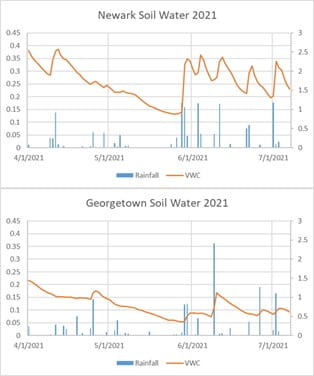Jarrod O. Miller, Extension Agronomist, jarrod@udel.edu
When looking at soil moisture levels and comparing rainfall events, soil texture, infiltration, and drainage become very important. If you don’t have soil moisture sensors, you can track regional values from DEOS (http://www.deos.udel.edu/). Soils higher in clay have greater volumetric water holding capacity (VWC) than sandy soils, although sandier soils will drain faster after high rainfall events.
When observing rainfall since April across Delaware, the advantage of certain soil types is clearer. Georgetown’s sandier soils hold less overall water, which is apparent on April 1st, where Georgetown VWC is 0.2 and Newark is 0.38 (Figure 1). They have not always received the same rainfall events but did steadily dry out from May until early June. Once rain returned to the region, Newark quickly regained soil moisture, while 1 inch rainfalls barely filled Georgetown soils. It took up to 2 inches of rain mid-June to significantly impact VWC in Georgetown soils.

Figure 1. Soil moisture and rainfall in Newark and Georgetown
It is important to remember that finer textured soils hold more water, but less is available to the plants. This means that Georgetown may hold less, but a lot more of what is there can be absorbed by crops. Besides adding organic matter, it is very hard to change your soil VWC, since it is tied to soil texture. However, you can improve soil water by maintaining good infiltration, by reducing compaction and maintaining surface pore space through no-till where it works in your cropping system. Poor infiltration even occurs in our sandier soils, where one year of no-till cover crops has much less runoff and more infiltration (Figure 2).

Figure 2. Poor drainage is present in a nearby conventional tilled sandy soil.
